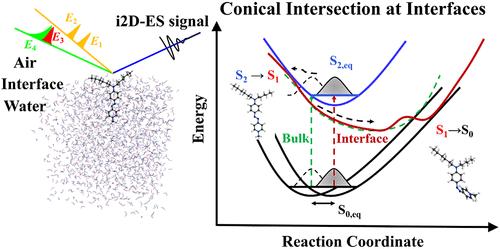当前位置:
X-MOL 学术
›
J. Am. Chem. Soc.
›
论文详情
Our official English website, www.x-mol.net, welcomes your
feedback! (Note: you will need to create a separate account there.)
Conical Intersections at Interfaces Revealed by Phase-Cycling Interface-Specific Two-Dimensional Electronic Spectroscopy (i2D-ES)
Journal of the American Chemical Society ( IF 14.4 ) Pub Date : 2024-07-22 , DOI: 10.1021/jacs.4c06035 Zhi-Chao Huang-Fu 1 , Nikolay V Tkachenko 1 , Yuqin Qian 1 , Tong Zhang 1 , Jesse B Brown 1 , Avetik Harutyunyan 2 , Gugang Chen 2 , Yi Rao 1
Journal of the American Chemical Society ( IF 14.4 ) Pub Date : 2024-07-22 , DOI: 10.1021/jacs.4c06035 Zhi-Chao Huang-Fu 1 , Nikolay V Tkachenko 1 , Yuqin Qian 1 , Tong Zhang 1 , Jesse B Brown 1 , Avetik Harutyunyan 2 , Gugang Chen 2 , Yi Rao 1
Affiliation

|
Conical intersections (CIs) hold significant stake in manipulating and controlling photochemical reaction pathways of molecules at interfaces and surfaces by affecting molecular dynamics therein. Currently, there is no tool for characterizing CIs at interfaces and surfaces. To this end, we have developed phase-cycling interface-specific two-dimensional electronic spectroscopy (i2D-ES) and combined it with advanced computational modeling to explore nonadiabatic CI dynamics of molecules at the air/water interface. Specifically, we integrated the phase locked pump pulse pair with an interface-specific electronic probe to obtain the two-dimensional interface-specific responses. We demonstrate that the nonadiabatic transitions of an interface-active azo dye molecule that occur through the CIs at the interface have different kinetic pathways from those in the bulk water. Upon photoexcitation, two CIs are present: one from an intersection of an optically active S2 state with a dark S1 state and the other from the intersection of the progressed S1 with the ground state S0. We find that the molecular conformations in the ground state are different for interfacial molecules. The interfacial molecules are intimately correlated with the locally populated excited state S2 being farther away from the CI region. This leads to slower nonadiabatic dynamics at the interface than in bulk water. Moreover, we show that the nonadiabatic transition from the S1 dark state to the ground state is significantly longer at the interface than that in the bulk, which is likely due to the orientationally restricted configuration of the excited state at the interface. Our findings suggest that orientational configurations of molecules manipulate reaction pathways at interfaces and surfaces.
中文翻译:

相位循环界面特定二维电子光谱 (i2D-ES) 显示界面处的圆锥形交叉点
圆锥形交叉点(CI)通过影响其中的分子动力学来操纵和控制界面和表面分子的光化学反应路径。目前,还没有用于表征界面和表面 CI 的工具。为此,我们开发了相循环界面特定二维电子光谱(i2D-ES),并将其与先进的计算模型相结合,以探索空气/水界面分子的非绝热 CI 动力学。具体来说,我们将锁相泵浦脉冲对与特定于界面的电子探针集成,以获得二维特定于界面的响应。我们证明,界面活性偶氮染料分子通过界面 CI 发生的非绝热转变具有与本体水中不同的动力学途径。在光激发时,存在两个CI:一个来自光学活性S 2态与暗S 1态的交叉点,另一个来自渐进S 1与基态S 0的交叉点。我们发现界面分子在基态下的分子构象是不同的。界面分子与远离 CI 区域的局部激发态 S 2密切相关。这导致界面处的非绝热动力学比散装水中慢。此外,我们表明,从 S 1暗态到基态的非绝热跃迁在界面处明显长于体相中的非绝热跃迁,这可能是由于界面处激发态的取向受限构型所致。 我们的研究结果表明,分子的取向构型操纵界面和表面的反应途径。
更新日期:2024-07-22
中文翻译:

相位循环界面特定二维电子光谱 (i2D-ES) 显示界面处的圆锥形交叉点
圆锥形交叉点(CI)通过影响其中的分子动力学来操纵和控制界面和表面分子的光化学反应路径。目前,还没有用于表征界面和表面 CI 的工具。为此,我们开发了相循环界面特定二维电子光谱(i2D-ES),并将其与先进的计算模型相结合,以探索空气/水界面分子的非绝热 CI 动力学。具体来说,我们将锁相泵浦脉冲对与特定于界面的电子探针集成,以获得二维特定于界面的响应。我们证明,界面活性偶氮染料分子通过界面 CI 发生的非绝热转变具有与本体水中不同的动力学途径。在光激发时,存在两个CI:一个来自光学活性S 2态与暗S 1态的交叉点,另一个来自渐进S 1与基态S 0的交叉点。我们发现界面分子在基态下的分子构象是不同的。界面分子与远离 CI 区域的局部激发态 S 2密切相关。这导致界面处的非绝热动力学比散装水中慢。此外,我们表明,从 S 1暗态到基态的非绝热跃迁在界面处明显长于体相中的非绝热跃迁,这可能是由于界面处激发态的取向受限构型所致。 我们的研究结果表明,分子的取向构型操纵界面和表面的反应途径。

















































 京公网安备 11010802027423号
京公网安备 11010802027423号